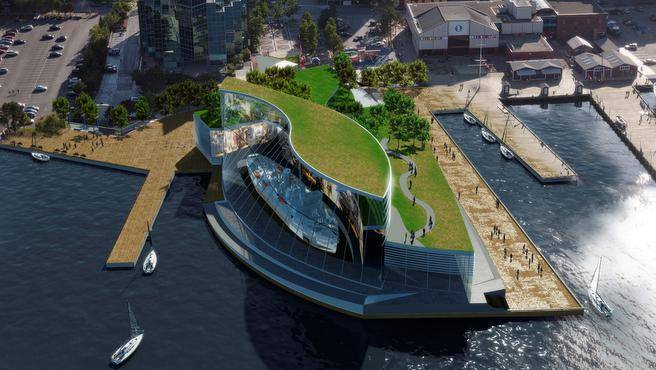
A view of the Halifax waterfront with the proposed Battle of the Atlantic Place museum. [Battle of the Atlantic Society]
Each voyage totalled dozens of ships of all kinds, massed to carry personnel, food and war materiel overseas between 1939 and 1945. And always, out there, waiting, searching, lurking was the undersea menace—the wolf packs and the lone wolves, captained by names like Günther Prien, Erich Topp and Joachim Schepke.
More than 70,000 Allied seamen, merchant mariners and airmen lost their lives in the Battle of the Atlantic, including 4,600 Canadians. It was the longest battle of the Second World War, lasting virtually the entire six years.
It has been described as history’s longest, largest and most complex sea battle, pitting the navies of Canada, Great Britain, the Soviet Union, France and others against Germany’s Kriegsmarine and its lethal U-boat fleet.
Some 3,500 merchant ships and 175 warships were sunk; 783 of 1,155 U-boats went to the bottom of the sea, taking with them 28,744 of just over 35,000 unterseeboot crew for a death rate of 82 per cent, the highest casualty rate of any armed forces of any conflict in the history of modern warfare.
It was an epic and heroic battle. The convoys were the Allies’ lifeline and at stake was nothing less than the outcome of the war itself and the future of the free world. It demanded a Herculean effort, technological innovation and untold resources.
Yet all that remains of one of its most iconic symbols, the corvette, is a single vessel—HMCS Sackville, tied up on the Halifax waterfront a few months a year.
Now a group called the Canadian Naval Memorial Trust is changing that, planning the construction of a museum and memorial on the Halifax waterfront that will serve as a permanent home for Sackville and a long-overdue testament to Canada’s pivotal role in the Battle of the Atlantic and the titanic change it brought about.
George Borgal, chairman of the trust’s Battle of the Atlantic Place project, has been making the rounds, drumming up support for the project among provincial commands of The Royal Canadian Legion.
It’s not money he wants from Legionnaires, but their support at next year’s dominion convention, where he’ll be looking for the Legion to endorse the project as “recognition of what a generation of veterans, their families and their communities did in transforming Canada and what it means to be Canadian.”
He will also ask for Legion help in gaining support from municipalities for a cross-Canada kiosk campaign “honouring those who sailed in naval and merchant ships named after their communities and regions, as well as those communities who contributed to the battle’s success by virtue of their industry and production.”
At the war’s outset, Canada’s navy was tiny—just six destroyers and about 3,500 personnel, a third of them reservists, according to The Canadian Encyclopedia. The country embarked on a massive shipbuilding effort, commissioning dozens of corvettes like Sackville, which were about half the size of a destroyer and armed with only a single gun and depth charges. They were quick and cheap to build, and carried a disproportionate share of convoy duties.
Appearing at Prince Edward Island Command’s 64th provincial convention on May 27, Borgal described the Battle of the Atlantic as the “successful achievement of a mammoth national challenge by the collective will of a generation of Canadians.”
Over the course of the conflict, Canada’s shipbuilding industry employed 126,000 workers. They built 487 warships, 400 cargo vessels and more than 3,000 landing craft. By war’s end, Canada’s navy consisted of more than 400 ships and 90,000 sailors. It was the fourth-largest navy in the world.
“This is not a story about the navy, the merchant service, or the maritime air forces, or even about HMCS Sackville, Canada’s naval memorial, which will be housed within this building,” said Borgal. “The story is much bigger—it’s about what all these elements mean together in the context of nation-building.
“The project encompasses a nation’s memory of what all its veterans did, whether in or out of uniform.”
It is the story of how a country of just 11 million people came together to transform itself from an agrarian society in 1939, into the “industrialized, skilled and confident nation it became in just six years, a country able to take its place as a fully independent and respected global leader.
“This was an achievement nothing short of remarkable, and became the foundation upon which the country we know today was built.”
Battle of the Atlantic Place will cost between $195 million and $225 million. Total government investment will cap at $180 million, the lion’s share from Ottawa. The balance will be borne by the not-for-profit Battle of the Atlantic Society and the contributions of Canadians and Canadian corporations and other sponsors.
It is a world-class project a long time in coming, and well worth backing.
Advertisement





















